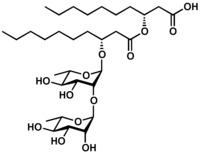
Production and application of a thermostable lipase from Serratia marcescens in detergent formulation and biodiesel production
Sign Up to like & getrecommendations! Published in 2018 at "Biotechnology and Applied Biochemistry"
DOI: 10.1002/bab.1565
Abstract: In this study, extracellular lipase was produced by Serratia marcescens wild type and three mutant strains. The maximum lipase activity (80 U/mL) was obtained with the SMRG4 mutant strain using soybean oil. Using a 22… read more here.
Keywords: production; removal; lipase; serratia marcescens ... See more keywords

Design and modularized optimization of one‐step production of N‐acetylneuraminic acid from chitin in Serratia marcescens
Sign Up to like & getrecommendations! Published in 2018 at "Biotechnology and Bioengineering"
DOI: 10.1002/bit.26782
Abstract: Chitin is an abundant, biorenewable, nitrogen‐rich biomass feedstock that can be potentially developed for biochemical production; however, efficient bioprocesses have yet to be established. Here, we demonstrate an engineered bioprocess to produce N‐acetylneuraminic acid (Neu5Ac)… read more here.
Keywords: production; optimization; serratia marcescens; acetylneuraminic acid ... See more keywords

First record of Serratia marcescens from Adelie and Gentoo penguin faeces collected in the Wilhelm Archipelago, Graham Land, West Antarctica
Sign Up to like & getrecommendations! Published in 2020 at "Polar Biology"
DOI: 10.1007/s00300-020-02682-7
Abstract: Until recently, Antarctic animal species were thought to be safely isolated from human-associated infections. However, recent studies have shown that Antarctic penguins carry microorganisms, some of which are potential human pathogens. We investigated one rookery… read more here.
Keywords: archipelago graham; wilhelm archipelago; penguin faeces; serratia marcescens ... See more keywords

Production of the biosurfactant serrawettin W1 by Serratia marcescens S-1 improves hydrocarbon degradation
Sign Up to like & getrecommendations! Published in 2021 at "Bioprocess and Biosystems Engineering"
DOI: 10.1007/s00449-021-02625-4
Abstract: With the frequent occurrence of oil spills, the bioremediation of petroleum hydrocarbons pollution has attracted more and more attention. In this study, we investigated the biodegradation of crude oil by the biosurfactant-producing strain S-1. The… read more here.
Keywords: production biosurfactant; biosurfactant; degradation; serratia marcescens ... See more keywords

Isolation and identification of two Serratia marcescens strains from silkworm, Bombyx mori
Sign Up to like & getrecommendations! Published in 2020 at "Antonie van Leeuwenhoek"
DOI: 10.1007/s10482-020-01442-1
Abstract: Bacterial septicemia commonly occurs and usually cause huge losses in sericulture industry. Here, two pathogenic bacterial strains were isolated from dead silkworm and named as ZJ-1 and ZJ-2. Phenotypic and genotypic analysis results revealed that… read more here.
Keywords: serratia; two serratia; serratia marcescens; marcescens strains ... See more keywords

Optimization of nickel and cobalt biosorption by native Serratia marcescens strains isolated from serpentine deposits using response surface methodology
Sign Up to like & getrecommendations! Published in 2022 at "Environmental Monitoring and Assessment"
DOI: 10.1007/s10661-022-09816-w
Abstract: The treatment of metal-polluted wastes is a challenging issue of environmental concern. Metals can be removed using microbial biomass, and this is an interesting approach towards the design of eco-friendly technologies for liquid waste treatment.… read more here.
Keywords: methodology; marcescens strains; cobalt biosorption; nickel cobalt ... See more keywords

Isolation and characterization of biosurfactant-producing Serratia marcescens ZCF25 from oil sludge and application to bioremediation
Sign Up to like & getrecommendations! Published in 2020 at "Environmental Science and Pollution Research"
DOI: 10.1007/s11356-020-09006-6
Abstract: A biosurfactant (BS) is a surface-active metabolite that is secreted by microbial metabolism, and can be used as a substitute for chemically synthesized surfactants. The first and most critical step to the successful application of… read more here.
Keywords: marcescens zcf25; producing serratia; application; serratia marcescens ... See more keywords

Adsorption behavior and mechanism of Serratia marcescens for Eu(III) in rare earth wastewater
Sign Up to like & getrecommendations! Published in 2021 at "Environmental Science and Pollution Research"
DOI: 10.1007/s11356-021-14668-x
Abstract: Directly discharging low-concentration rare-earth wastewater not only wastes rare-earth resources but also pollutes the environment. In this study, the biosorption behavior of Serratia marcescens for Eu(III) was studied with emphasis on the optimization of adsorption… read more here.
Keywords: adsorption; rare earth; serratia marcescens; earth wastewater ... See more keywords

Cloning, Expression and Characterization of Two Beta Carbonic Anhydrases from a Newly Isolated CO2 Fixer, Serratia marcescens Wy064
Sign Up to like & getrecommendations! Published in 2018 at "Indian Journal of Microbiology"
DOI: 10.1007/s12088-018-0773-6
Abstract: Bacterial strains from karst landform soil were enriched via chemostat culture in the presence of sodium bicarbonate. Two chemolithotrophic strains were isolated and identified as Serratia marcescens Wy064 and Bacillus sp. Wy065. Both strains could… read more here.
Keywords: ca1 ca3; co2 hydration; co2; ca3 ... See more keywords

Cytotoxic Effect of Prodigiosin, Natural Red Pigment, Isolated from Serratia marcescens UFPEDA 398
Sign Up to like & getrecommendations! Published in 2020 at "Indian Journal of Microbiology"
DOI: 10.1007/s12088-020-00859-6
Abstract: Prodigiosin is a secondary metabolite, with red pigmentation, produced by Serratia marcescens. Red pigment is a natural alkaloid whose chemical structure has three pyrrole rings. Prodigiosin has been described for several biological activities, including antitumor,… read more here.
Keywords: ufpeda 398; prodigiosin; serratia marcescens; red pigment ... See more keywords

Analytical study of effective biodegradation of p-cresol using Serratia marcescens ABHI001: application in bioremediation
Sign Up to like & getrecommendations! Published in 2017 at "3 Biotech"
DOI: 10.1007/s13205-017-1006-0
Abstract: This study evaluated the capability of Serratia marcescens ABHI001 to effectively degrade p-cresol through different techniques. The molecular identity of the laboratory isolate S. marcescens ABHI001 was confirmed through the 16S ribosomal DNA gene pattern,… read more here.
Keywords: cresol; marcescens abhi001; bioremediation; study ... See more keywords